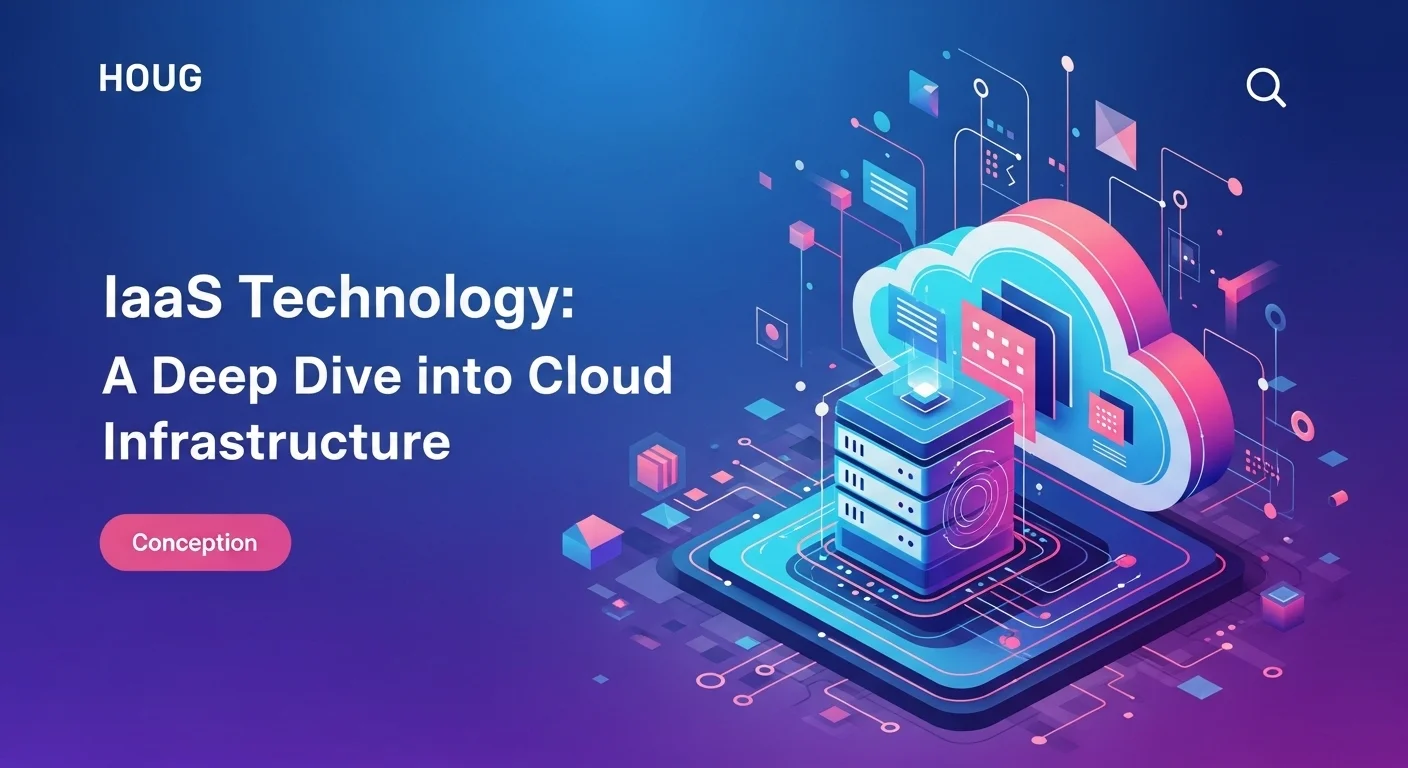What is IaaS? A Personal Guide to Cloud Infrastructure

Executive Summary
Remember the days of needing a dedicated server room, with all the costs, cooling, and maintenance that came with it? Infrastructure as a Service (IaaS) completely changed that game. It lets businesses rent computing power, storage, and networking from the cloud instead of buying and managing physical hardware. In this guide, I'll walk you through everything you need to know about IaaS, the real foundation of the cloud. We'll explore what it is, how it can fuel growth, power big data projects, and even save your business in a disaster. We'll look at the major players, including Google's offerings, and see practical examples of how companies are using IaaS to get ahead. Whether you're a business leader planning your next move or a tech lover curious about how the cloud really works, this is for you.
Table of Contents
- What is IaaS and why is it important in Technology?
- The Core Components of an IaaS Platform
- Business Applications and Transformative Benefits
- Complete guide to Iaas in Technology and Business Solutions
- Choosing the Right IaaS Platform: A Technical and Business Analysis
- Comparing the Titans: A Look at Major IaaS Companies
- Implementing and Managing IaaS: Business Techniques and Resources
- Tips and strategies for Iaas to improve your Technology experience
- Mastering IaaS Security: Best Practices for a Hardened Environment
- Strategic Cost Optimization: Getting More for Less
- Enhancing Performance and Reliability
What is IaaS and why is it important in Technology?
Let's talk about Infrastructure as a Service, or IaaS as you'll usually hear it called. At its heart, it's a foundational cloud computing model that lets you rent IT infrastructure—servers, storage, networking—over the internet. I've worked with countless businesses making this switch, and the biggest 'aha' moment is always when they realize they no longer need a physical server room. Instead of buying expensive hardware, they lease it from a cloud provider. The provider, like Google Cloud or AWS, handles the physical machines, while you manage the software on top, like the operating system and your applications. This shared responsibility is key, giving you a perfect blend of control and convenience that has truly reshaped the tech world.
The importance of IaaS today is massive. It's the bedrock that other cloud services, like PaaS (Platform as a Service) and SaaS (Software as a Service), are often built on. Its real magic lies in the incredible speed and scalability it offers. In my early days in IT, getting a new server could take weeks. With IaaS, you can get one up and running in minutes. This speed allows businesses to react to market changes almost instantly. Imagine an e-commerce store during a holiday sale; they can instantly add more server power to handle the traffic spike and then scale back down when things quiet down to save money. That flexibility, known as elasticity, is a game-changer.
The Core Components of an IaaS Platform
To really get what IaaS is about, you need to understand its three main ingredients, all delivered virtually:
- Compute: This is the processing power, delivered through what we call virtual machines (VMs). Think of a VM as a digital version of a physical computer. Providers offer a huge menu of VMs with different amounts of CPU and memory (RAM), and even specialized hardware like GPUs for heavy-duty tasks like AI or data analysis. You pick the size you need, from a small one for a test website to a huge cluster for processing big data. For instance, Google's IaaS offering, Google Compute Engine, lets you customize your VMs with incredible detail.
- Storage: Cloud infrastructure offers different ways to store your data. There's block storage, which acts like a traditional hard drive and is great for operating systems and apps needing fast access. Then there's object storage, perfect for holding massive amounts of unstructured data like photos, videos, or backups—it's incredibly scalable and durable. Amazon S3 and Google Cloud Storage are classic examples of object storage that many of us use every day. There's also file storage for shared access across multiple VMs. This variety lets you pick the most cost-effective solution for your needs.
- Networking: IaaS providers give you a full suite of virtual tools to build your own private network in the cloud. This includes creating isolated network spaces (Virtual Private Clouds or VPCs), using load balancers to spread traffic and prevent overloads, setting up firewalls for security, and managing domain names (DNS). It’s like having a physical network closet, but everything is defined and controlled by software, giving you immense flexibility.
Business Applications and Transformative Benefits
The ways businesses use IaaS are practically endless. One of the most common I see is for development and testing. Developers can spin up new environments in minutes to test code and then delete them when they're done, speeding up innovation without the cost of physical gear.
Hosting websites and applications is another huge use case. IaaS provides the scalable power needed for everything from a personal blog to a complex, high-traffic web service. The pay-as-you-go pricing makes it affordable for everyone. For tasks that require a lot of power, like big data analytics, IaaS is a lifesaver. It provides the on-demand computational muscle needed to process giant datasets. The same goes for training AI models, which often requires specialized GPUs that are easy to rent on an IaaS platform.
Disaster Recovery is another area where IaaS shines. In the past, setting up a backup data center was incredibly expensive. With IaaS, you can replicate your critical systems to a provider's facility in another part of the world for a fraction of the cost, ensuring your business can stay online even if your primary site goes down.
The benefits are clear. The first is cost savings. You trade a large upfront investment in hardware for a predictable monthly operational expense, and you only pay for what you use. Scalability and flexibility are just as important, letting you grow or shrink your resources as needed. Reliability is also a huge plus. The major IaaS providers have global networks of data centers, so you can place your application closer to your users for better performance, and they offer uptime guarantees that are tough to match on your own. Ultimately, IaaS levels the playing field. It gives small startups access to the same powerful technology as giant corporations, which is a powerful engine for innovation. The cloud infrastructure space is led by giants like Amazon Web Services (AWS), Microsoft Azure, and Google Cloud Platform (GCP). Each has its strengths, and understanding them is key to choosing the right partner for your journey into the cloud.

Complete guide to Iaas in Technology and Business Solutions
Going beyond the basics of Infrastructure as a Service (IaaS) opens up a world of strategic possibilities. To truly leverage the cloud, you need a solid plan. This guide is my take on the technical methods, business tactics, and resources you'll need to develop a winning IaaS strategy. It’s all about helping you choose and manage the right platform to drive real growth and innovation.
Choosing the Right IaaS Platform: A Technical and Business Analysis
Picking an IaaS platform is a major decision for any business. You're not just buying a service; you're choosing a partner for the future. From my experience, the best choice comes from a careful analysis that balances your tech needs with your business goals.
Technical Evaluation Criteria:
- Performance and Reliability: Let's be honest, not all clouds perform the same. It's crucial to look at the raw performance of a provider's virtual machines and storage. I often recommend benchmarking your specific applications to see how they run. Check out their global network, latency between data centers, and their official uptime promises (SLAs). Read the fine print on those SLAs to see what happens if they don't meet their guarantees.
- Service Portfolio: Look beyond the basic compute and storage. What else is on the menu? A rich set of services can be a huge plus. This includes databases, data analytics tools, AI/ML services, and security features. For example, a big reason people choose Google's IaaS is for its top-tier AI Platform and BigQuery, which are deal-breakers for data-heavy companies.
- Interoperability and Open Standards: Nobody wants to be locked into a single vendor. A provider that uses open standards like Kubernetes for containers makes your life so much easier. It gives you the freedom to build a multi-cloud or hybrid-cloud setup, letting you move work between your own data center and the cloud, or even between different cloud providers.
- Security and Compliance: Security in the cloud is a partnership. The provider secures the cloud itself (the physical hardware), but you're responsible for securing what's *in* the cloud (your data and apps). Look closely at their security measures and the tools they give you. Also, make sure they comply with any regulations that affect your industry, like HIPAA for healthcare or PCI DSS for finance.
Business and Financial Considerations:
- Pricing Models: IaaS pricing can get complicated. While 'pay-as-you-go' is the standard, you can get big discounts for committing to long-term use (Reserved Instances). It’s essential to understand all the little costs, like data transfer fees and support plans, to avoid surprises on your bill. The cost management tools a platform offers can be just as important as the prices themselves.
- Ecosystem and Partner Network: A provider’s community is a big deal. Look at their marketplace for third-party software, the availability of managed service providers, and the number of certified professionals out there. A strong ecosystem means you’ll find help, tools, and integrations more easily.
- Geographic Presence: If you have users around the world, the provider's data center locations are critical. Placing your app closer to your users means lower latency. It can also be a legal requirement to keep data within certain countries.
Comparing the Titans: A Look at Major IaaS Companies
The IaaS market is dominated by a few giants. Here’s my quick rundown of the big three:
- Amazon Web Services (AWS): As the pioneer, AWS has the most services and the biggest global footprint. Its maturity means there's a huge community and tons of documentation. I've found it's often the go-to choice for startups because of its sheer flexibility and breadth.
- Microsoft Azure: Azure’s biggest advantage is its seamless integration with the Microsoft world. If your company runs on Windows Server and Office 365, Azure feels like a natural extension. It’s a powerhouse in the enterprise market.
- Google Cloud Platform (GCP): Google's IaaS stands out in highly technical areas. Built on the same infrastructure that powers Google Search and YouTube, it's known for its incredible network, its leadership in containers with Kubernetes, and its powerful data and AI tools. It's a favorite for companies focused on cloud-native apps and machine learning.
Other players like Alibaba Cloud, IBM Cloud, and Oracle Cloud also have their niches, often focusing on hybrid cloud for their existing enterprise customers.
Implementing and Managing IaaS: Business Techniques and Resources
Moving to an IaaS solution is just the beginning. The real work is in managing it effectively for the long haul.
Migration Strategies:
When moving to the cloud, a common starting point is 'Lift and Shift,' where you move an application with minimal changes. It's fast, but you won't get all the cloud benefits. 'Replatforming' involves a few tweaks to take better advantage of the cloud, while 'Refactoring' is a full redesign for a cloud-native architecture. The best path depends on your goals and resources.
Cloud Financial Management (FinOps):
Managing cloud costs requires a new way of thinking called FinOps. It's about making everyone responsible for the money being spent. This means constantly monitoring costs, shutting down unused resources, and using discounts wisely. All providers offer tools for this, but success comes from building it into your company culture.
Automation and Infrastructure as Code (IaC):
To manage cloud infrastructure efficiently, you have to automate. Infrastructure as Code (IaC) means defining your infrastructure in configuration files. Tools like Terraform and Ansible let you version, replicate, and manage your cloud environments reliably. In my opinion, you can't achieve the true speed and consistency of the cloud without IaC.
In the end, mastering IaaS is a journey from smart selection to operational mastery. By carefully weighing your needs, comparing the top providers like Google IaaS, and adopting modern practices like FinOps and IaC, you can build a powerful foundation for your business's future.

Tips and strategies for Iaas to improve your Technology experience
Getting onto an Infrastructure as a Service (IaaS) platform is step one. The real challenge—and where the magic happens—is optimizing it for top-tier performance, security, and cost-efficiency. Here are my go-to tips and strategies to truly enhance your experience with IaaS, based on years of working in the cloud.
Mastering IaaS Security: Best Practices for a Hardened Environment
Remember, in the IaaS model, security is a partnership. Your provider secures their infrastructure, but you have to secure everything you put on it. A layered defense is the only way to go.
- Adopt a Zero-Trust Mindset: The guiding rule here is 'never trust, always verify.' Assume no user or device is safe by default. Use strong identity and access management (IAM) and give people only the permissions they absolutely need. And please, enforce Multi-Factor Authentication (MFA) everywhere. It's one of the simplest and most effective security measures you can take.
- Segment Your Network: Use the tools your IaaS platform provides to create isolated network zones for different parts of your application (e.g., web servers in one zone, databases in another). This is called microsegmentation. Lock down the traffic between these zones with virtual firewalls, only allowing what's necessary. Platforms like AWS VPC and Google's Virtual Private Cloud are built for this.
- Encrypt Everything: Your data is your treasure. Protect it by encrypting it both when it's moving across the network (in transit) and when it's sitting on a disk (at rest). All major IaaS providers offer easy-to-use services like AWS KMS or Google Cloud KMS to manage your encryption keys.
- Keep a Watchful Eye: You can't stop a threat you can't see. Set up comprehensive logging and monitoring for all your cloud resources. Use native tools like AWS CloudTrail or Google Cloud's operations suite to track who is doing what, and when. Consider adding tools that can automatically detect and respond to suspicious activity.
- Manage Vulnerabilities: Regularly scan your virtual machines and applications for known security holes. Automate patching to make sure you're always protected against the latest threats. This is not a one-time task; it's a continuous process.
Strategic Cost Optimization: Getting More for Less
I've seen it happen too many times: cloud bills that spiral out of control. With a smart approach, you can cut costs significantly without hurting performance.
- Right-Size Your Resources: Overprovisioning is the most common way to waste money in the cloud. Use monitoring tools to see how much CPU and memory your VMs are actually using. If an instance is consistently underutilized, shrink it down. It's a simple change that can save you a lot.
- Embrace Autoscaling: If your application traffic goes up and down, use autoscaling. It will automatically add or remove servers based on demand. This ensures you have the power you need during peaks and save money during quiet periods. It's a perfect example of cloud elasticity.
- Commit for Discounts: If you have a steady, predictable workload, don't just pay as you go. You can get huge discounts (often over 70%) by committing to a one- or three-year plan. AWS has Savings Plans, Azure has Reservations, and Google's IaaS has Committed Use Discounts (CUDs). It's a key strategy for optimizing your bill.
- Shut Down What You're Not Using: It sounds basic, but you'd be surprised how often development and test environments are left running 24/7. Create simple scripts to automatically shut them down outside of business hours.
- Watch Your Data Transfer Costs: Moving data out of the cloud can be expensive. Design your architecture to minimize this. Using a Content Delivery Network (CDN) to serve content closer to your users is a great way to reduce these fees and improve performance at the same time.
Enhancing Performance and Reliability
A well-run IaaS environment isn't just secure and cheap; it's also fast and reliable for your users.
- Choose the Right Location: Place your applications in the geographic region closest to your users to reduce lag. Within that region, spread your app across multiple Availability Zones (AZs), which are separate data centers. This protects you if one data center has an issue.
- Use Load Balancing: Never bet on a single VM. Put a load balancer in front of a group of VMs to distribute traffic evenly. This boosts reliability and makes it easy to scale by simply adding more VMs to the group.
- Optimize Your Storage: Pick the right storage for the job. Use high-performance SSD storage for databases and other apps that need speed. Use cheaper object storage for things like backups and static files.
- Implement Caching: Caching is one of the best ways to speed things up. Use in-memory caches like Redis for data that's accessed frequently, and use a CDN for your website's static content like images and CSS files.
By putting these strategies into practice, you can turn your IaaS platform into a powerful, efficient, and secure foundation for your business. It takes a mix of the right tools and the right mindset, but the payoff in performance, security, and cost savings is well worth it.
Expert Reviews & Testimonials
Sarah Johnson, Business Owner ⭐⭐⭐
The information about IaaS is correct but I think they could add more practical examples for business owners like us.
Mike Chen, IT Consultant ⭐⭐⭐⭐
Useful article about IaaS. It helped me better understand the topic, although some concepts could be explained more simply.
Emma Davis, Tech Expert ⭐⭐⭐⭐⭐
Excellent article! Very comprehensive on IaaS. It helped me a lot for my specialization and I understood everything perfectly.



